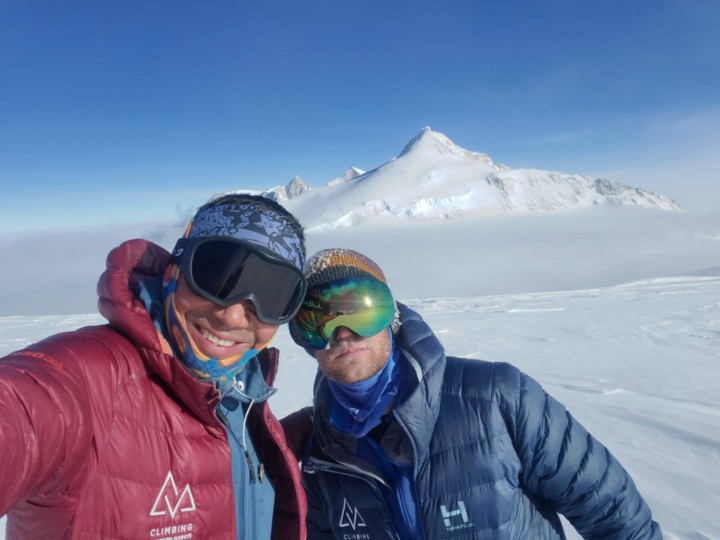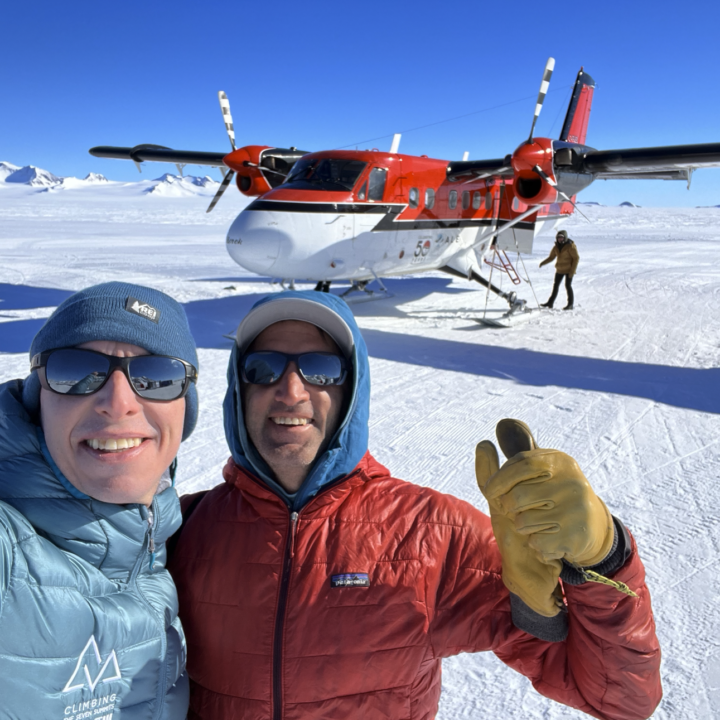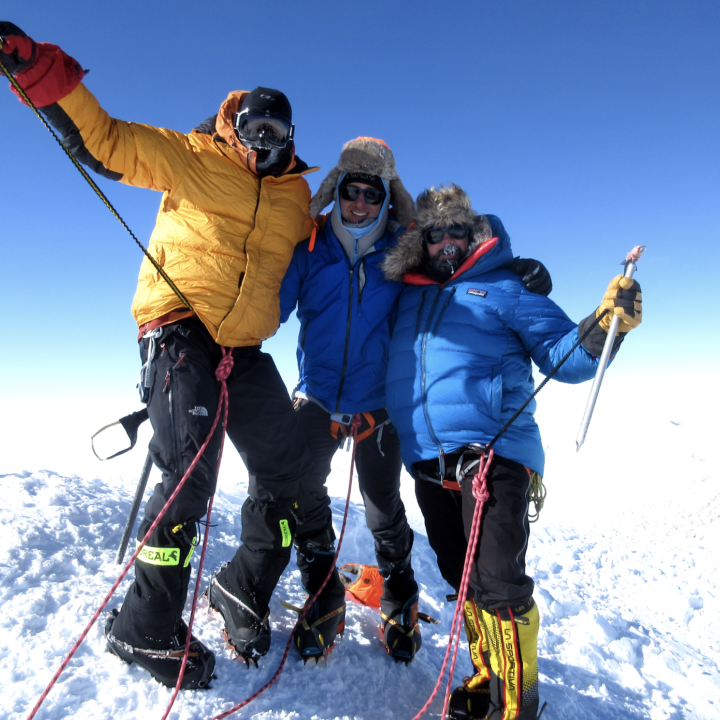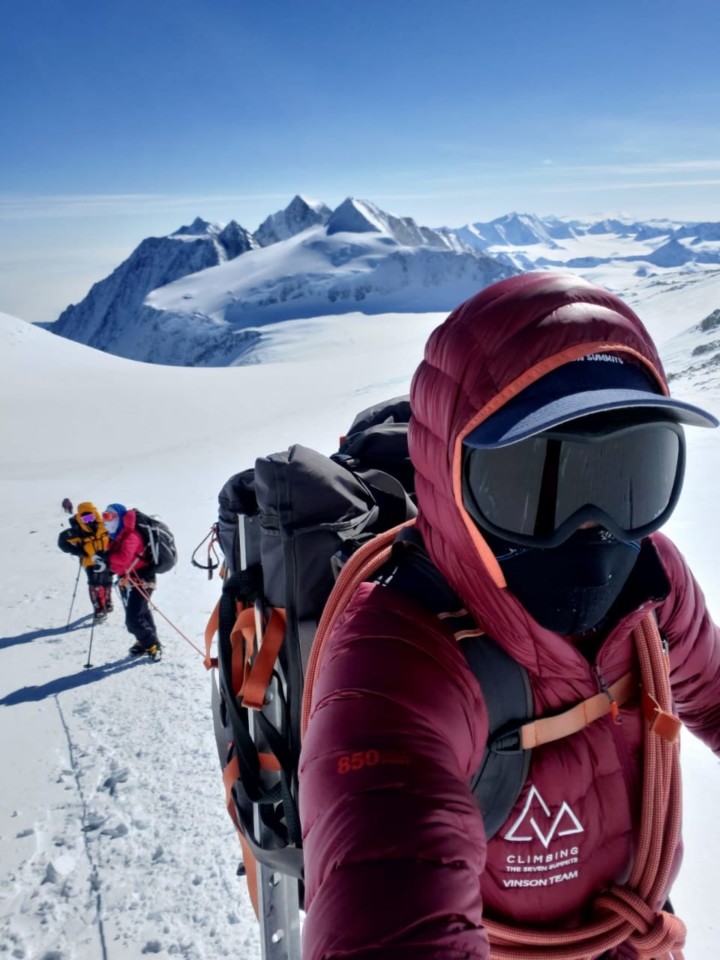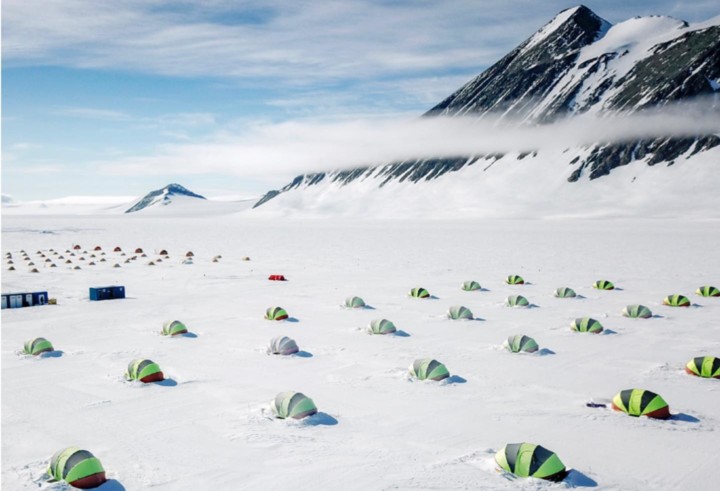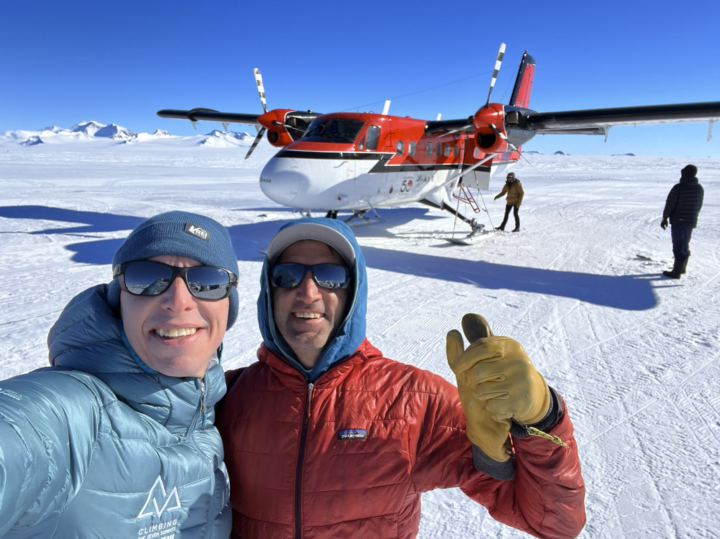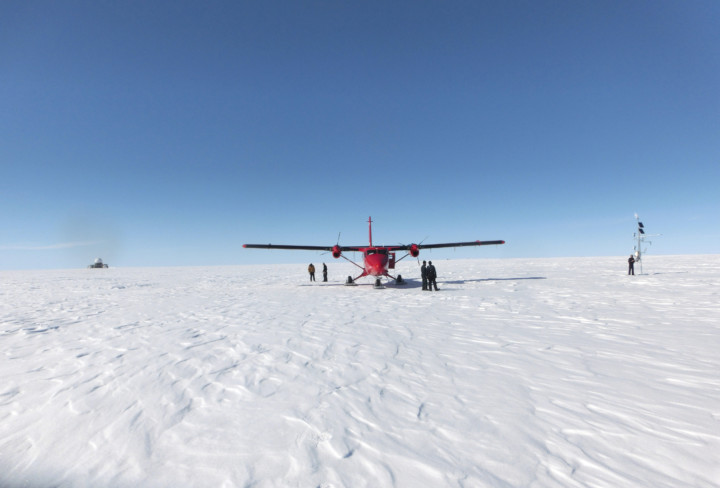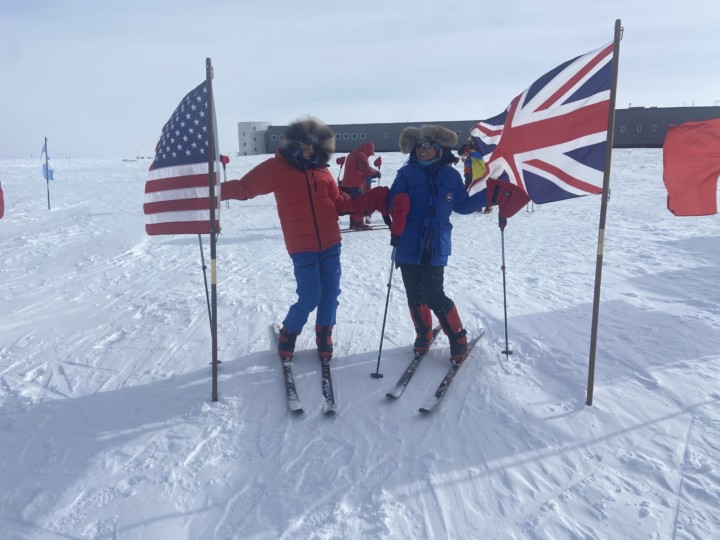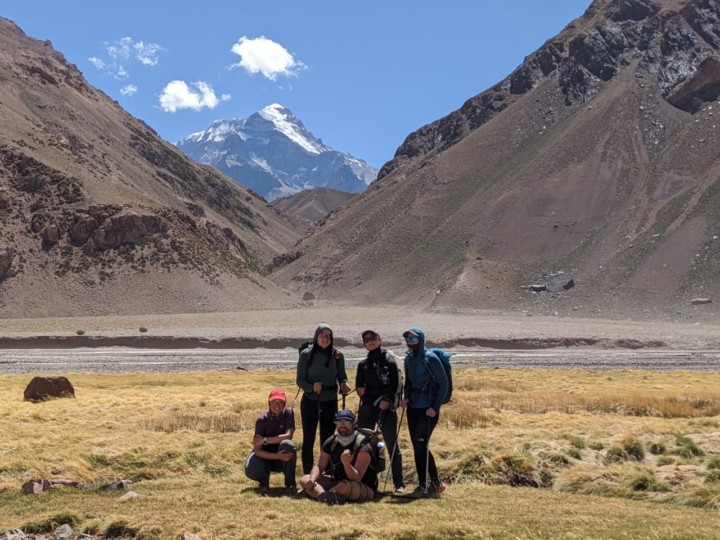Vinson Advice from Mike Hamill
Personal advice on climbing Aconcagua from Mike Hamill

Mount Vinson is absolutely my favorite of the Seven Summits. Nestled deep in Antarctica, ascending one of the most isolated mountains on our planet is an unparalleled and exclusive privilege. Few climbers have the opportunity to climb this peak, and Vinson has far fewer summits than Mt Everest.
The journey to the mountain alone is an adventure. Accessible only for a brief period each year, the anticipation builds as we gather at the southernmost tip of South America before boarding another flight over the Southern Seas to Antarctica, touching down in the interior on a runway of blue ice. From there, we hop onto specialized ski planes to Vinson Base Camp.
After arriving at Vinson Base Camp, we’re ready for the climb. It’s a special feeling watching the small ski plane depart, leaving you and your team alone with the mountain. The humility and thrill of being as remote from civilization as possible—and the climb has yet to begin!
Here are a few things I’d like to offer up as some advice when you are heading to Vinson:
- Don’t underestimate the cold. Removing your face covering or a glove can lead to a cold injury. Listen closely to your guides and copy what they do to take care of themselves. Stay disciplined in keeping covered up to prevent frostnip or frostbite..
- Invest in the right gear. Having the right gear is critical. Polar temperatures are serious, and you need to closely follow our gear guides sent prior to your trip to make sure you’re prepared. Make sure you adhere to specific warmth ratings. Don’t try to cut corners, or “make do” with old systems/gear. On Vinson, make sure you protect yourself with the right clothing, climbing boots, sleeping bag, etc.
- Training for Vinson. Moving from Base Camp to Low Camp, we often use sleds pulled behind us to spread our pack weight and move more gear and equipment up the mountain. One of the most valuable ways to train for Vinson is by dragging a large car tire connected to your harness while wearing a weighted pack. It will train your body to pull and strengthen all the small stabilizer muscles you otherwise wouldn’t work in the gym. You don’t want your muscles to be sore on Day 1 of the climb.
- Manage expectations. Make sure your work and family understand the trip length and lack of communication. It is rare, but lengthy delays do happen without access to a cell or internet connection. The planes on the ice won’t fly in anything other than perfect conditions, so if you get a storm or poor visibility, you could be sitting at Base Camp for days on end. Bring a Kindle with preloaded books, and download some good podcasts or movies to your phone and a small portable solar system like a Goal Zero to recharge your device batteries.
- Expect to feel more physically taxed on Vinson. The relentless cold, the confusion that 24-hour daylight has on your body clock, and most importantly, the way the atmospheric pressure in Antarctica affects altitude perception. At the North and South Poles, the atmosphere has relatively low pressure compared to sea level, so it will feel higher, and you will feel more fatigued than on other mountains of similar altitude.
- Research Antarctica. Before you arrive, dive into the rich exploration history of this icy continent. It will intensify the experience as you imagine what the early explorers faced compared to our comfy base camp and present-day gear and equipment.
I’ve always found Vinson one of the most thrilling and life-changing of the Seven Summits, and I’m sure you will, too.
The explorers, adventurers, and mountaineers you meet in the heart of Antarctica are some of the most humbling, high-achieving, and fascinating people on Earth. Having the opportunity to connect with them and call them friends will be one of the most life-changing elements of your expedition.
Best Wishes,
Mike
Vinson Training & Prerequisites
Experience Level
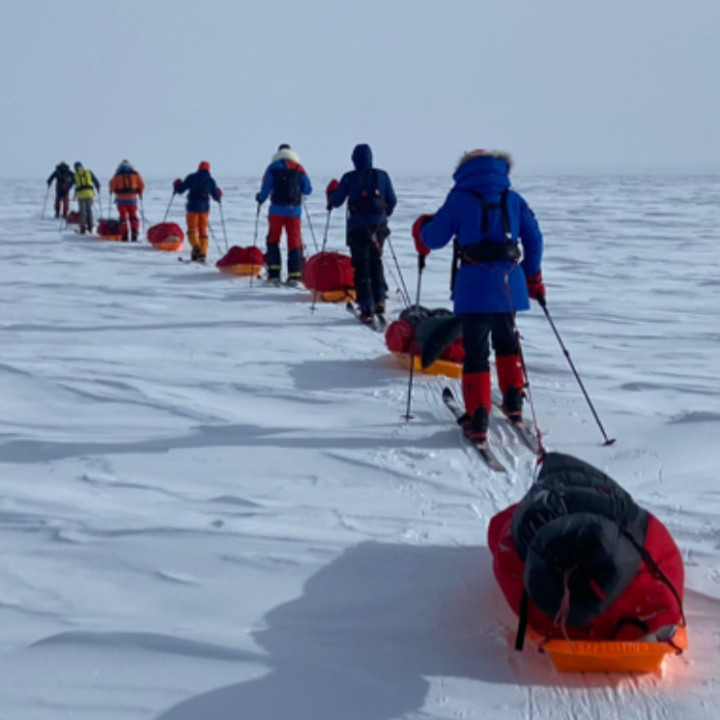
Vinson is a serious undertaking meant for climbers with prior experience in the cold and some climbing skills. Guides will work with clients throughout the expedition to provide safety, advice, logistics, technical guidance, and information to best ensure the clients’ summit success.
Physical Training
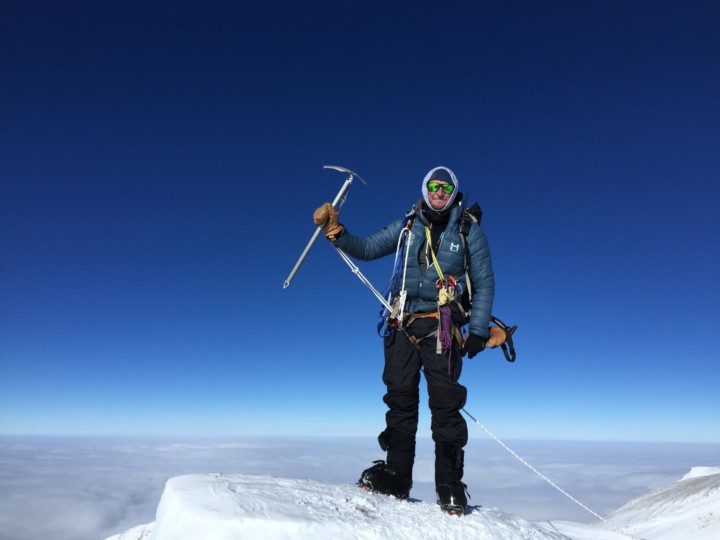
Your climb begins long before you reach the ice. We encourage you to incorporate training into your daily routine at least six months before the departure date. As your climb rolls around, you want to be in top physical and mental condition. Being fit at home is different from being strong at high altitudes and in extreme conditions.
Mindset

Mindset and mental preparation are integral to your success on any peak.
You should be prepared to:
- Be away from home/work for the duration of your climb
- Have a desire for rugged adventure travel
- Be open to receiving and deferring to guidance, support, and advice from your guides/expedition leaders even if you are an experienced mountaineer
- Be comfortable having open conversations with your guides
- Be able to work well in a team environment by being supportive and respectful of fellow teammates
- Be humble, respectful, and considerate even under pressure
Vinson Expedition Beta & Route
Elevation: 16,050 feet
Duration: 16 days
Difficulty: Advanced
Route: Branscomb Shoulder Route
Continent: South America and Antarctica

Route Choice
We have chosen the Branscomb Shoulder route on Vinson for the best chances of summit success. This route is located on the southern side of Mount Vinson and begins at Vinson Base Camp. This route is often dubbed the standard route as it is a more moderate option to the summit of Vinson, but it still presents significant challenges, including crevasses, icefalls, and harsh weather conditions.
The route is named after the Branscomb Glacier, which flows along the southern slopes of Mount Vinson. The “shoulder” refers to a feature on the mountain where the route traverses, leading climbers towards the summit.
The Branscomb Shoulder route consists of low-angle glacier walking at lower elevations with some moderately steep fixed-rope and ridge walking as the elevation increases. Overall, the climbing is incredibly enjoyable, albeit cold, and very doable. Taking advantage of the endless daylight, we’ll climb when conditions are best, working up through Low Camp to High Camp in preparation for our summit bid.
How to Choose The Right Vinson Expedition
How to Choose The Right Vinson Expedition
Share Expedition
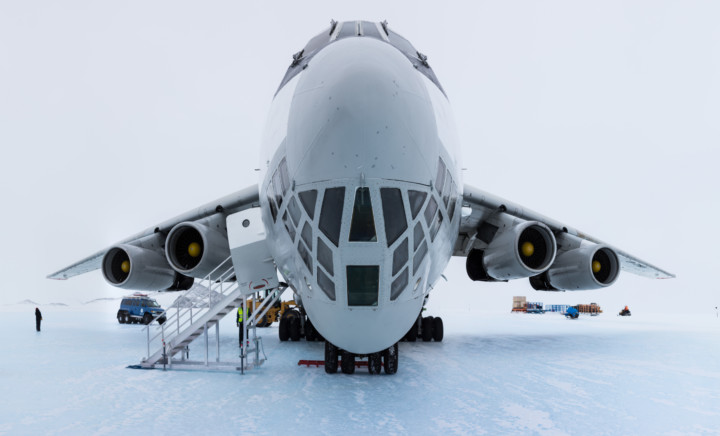
It is important to research and choose the right expedition company to support you, help guide you through all logistics, and be there for you on the mountain. You want to do your homework so you feel 100% confident in your choice and can focus on the climb.
We encourage you to look closely at both the big picture and the small details. Consider a company’s priority on safety, the quality and experience of its guides, its reputation, and its level of “care factor.”
Safety & Success
Your safety and success are the top priorities, in that order.
A climbing company should invest heavily and plan extensively for your safety.
Climbing the Seven Summits is committed to providing the highest-quality expeditions on Vinson Massif. You can be assured that it will be both challenging and fun, a true once-in-a-lifetime experience. As always, our professional priorities are safety and success, which we achieve by outfitting our teams with the best logistics and the most capable, qualified, and seasoned guides in the world.
CTSS is pleased to boast a 100% expedition success rate on our Vinson expeditions. Who you choose as the outfitter of your Vinson expedition will be one of the most important decisions you’ll make. Sound leadership is the difference between a great expedition and a miserable experience.
Leadership
This expedition will be organized by Mike Hamill, Owner of Climbing the Seven Summits. Mike has personally guided nearly 20 Vinson expeditions, 11 Mount Everest expeditions, 24 X 8,000m expeditions, 6 Mount Everest summits, currently holds the record for most non-Sherpa summits of Cho Oyu, and has written the guidebook to “Climbing the Seven Summits,” making him one of the most experienced guides on the mountain. More than 100 summits have been notched on Vinson under Mike’s direct leadership. Climbing the Seven Summits expeditions are meticulously organized with the best logistics.
We feel that our guides are incredibly important to our success. CTSS employs only world-class leaders who are known for their focus on client care and experience.
Vinson is a serious undertaking meant for climbers with prior experience in the cold and some climbing skills. Guides will work with clients throughout the expedition to provide safety, advice, logistics, technical guidance, and information to best ensure the clients’ summit success.
Values & Philosophy
This is sometimes a little harder to identify as it’s more a feeling than a sales pitch, but you should get a feel for a company through their little interactions, their care factor, their attention to detail, their corporate social responsibility, their responses to you.
Mountaineering can be high-risk and stressful, so pick an operator who has strong core values and a team mentality that aligns with yours. When things get challenging, you can rely on open lines of communication, knowing they will do what they can to support you.
It is this team cohesiveness that flows through to each individual climber and helps them stand on top.
Vinson Travel Guide
Expedition Meets in: Punta Arenas, Chile
Continents: South America and Antarctica
Currency: Chilean peso in Chile and US dollar in Antarctica
Population: 124,169 (Punta Arenas, Chile) and 1,000 – 4,000 (Antarctica)
Official Language: Spanish in Punta Arenas, Chile, and no official language in Antarctica, but English, Spanish, and Russian are among the most commonly spoken languages at the research stations.
Seasons to Climb: During the Antarctic summer you can take advantage of the warmer climbing temperatures and reduce the risk of frostbite.
Getting There & Meeting Location:
Getting to Punta Arenas, Chile, is relatively straightforward, with several airlines offering flights to and from the city each day. Due to its southerly latitude, most climbers will have more than 12 hours of flights to reach Punta Arenas. Please pay close attention to your flight times, layovers, and leave date. In the days leading up to your flight, double-check that your flight has not been canceled or changed.
Most flights to Punta Arenas connect through Santiago. Remember to collect your checked luggage BEFORE clearing customs. You will then need to re-check your bags for your domestic flight to Punta Arenas at the domestic terminal. If your luggage does not arrive, please complete a missing form/claim for lost luggage BEFORE leaving the Santiago airport.
The first day of your itinerary is an arrival day, meaning you can book your flights to arrive in Punta Arenas at any time on that first day. We strongly recommend arriving a day in advance, if possible (the day before the arrival day), or at the very least in the morning or early afternoon of Day 1.
Possible flight and luggage delays are two of the reasons we have scheduled a few buffer and prep days in Punta Arenas, as the Antarctic flight service will not hold flights onto the ice for delayed passengers, luggage, or any other reason.
We’ve built in a planning day after everyone arrives in Punta Arenas on Day 2. The whole team will meet this day, usually at breakfast, to make introductions, have our team briefing, and answer any questions.
Upon arrival in Punta Arenas, it is easy and affordable to grab a taxi to your hotel. CTSS will email you prior to the climb with updated hotel information to make sure you get to the right spot. Check in at the front desk and let your guide know you made it. Relax and unwind, knowing that you have no formal activities today. Your guide may be out buying and packing food but will check in with you as soon as possible upon returning to the hotel.
Punta Arenas, Chile International Airport
- Presidente Carlos Ibáñez del Campo International Airport (PUQ)
Expedition Transportation:
Your flights in Punta Arenas, Chile to and from Union Glacier, Antarctica, and Vinson Base Camp are included in your expedition.
Accommodation:
Your expedition includes all of your accommodations, as noted in the inclusions and exclusions.
Money:
It is better to have more money than you need than not enough. Most things are covered on the trip once you land in Chile. You can review the inclusions and exclusions list for more details. Once you land in Punta Arenas, Chile, you can exchange your money for Chilean pesos to use while you are in Punta Arenas. While in Antarctica, you can use US dollars.
Tipping:
Tipping is customary while you are in Chile. Tipping taxi drivers is not expected, but rounding up is appreciated. A tip of 1,000 pesos per night per person is considered a good tip for housekeeping, and a little tip per bag is expected for bellhops. Guide tips, although not required, are always appreciated by our dedicated guide staff.
Language:
Chile’s official language is Spanish. While in Punta Arenas, you should expect difficulty finding English-speaking shopkeepers or the general public. Most hotel front desk employees will have some command of English, and our logistics staff speak English well.
The common language in Union Glacier, Antarctica, is English.
Cell Phone Coverage:
Chile Country Code: +56
While you may find cell coverage in Punta Arenas, Chile, please check with your provider about roaming or international charges. Wi-fi calling from hotels in Punta Arenas is also an option.
There is no cell phone coverage in Antarctica. All communications must be done via satellite phone or text on the Iridium satellite network. CTSS will have a satellite phone that can be made available to clients at $3 per minute on a very limited basis. Please don’t count on having frequent access to the satellite phone, as we want to conserve battery power in case of an emergency. Please prepare your friends and family at home to be out of communication and to rely on the blog/CTSS for updates. Remember that no news is good news. Family and friends need to understand that the blog may not get updated every day and that the lack of updates does not indicate any problems.
Local Emergency Contacts:
In Chile, you can reach emergency services by dialing:
Ambulance: 131
Fire: 132
Police: 132
International Arrivals & Visas:
If you are transferring through Santiago, Chile, you will need to clear customs there, claim your bags at the international terminal, and recheck them at the domestic terminal. Upon exiting the plane, walk to the customs area and have your passport and visa form handy. This process can take some time, so make sure you have at least three hours between flights. It can take up to an hour to clear customs, depending on the number of flights landing. If it is your first time in Chile, you may be required to buy a visa upon arrival at a desk just before getting into the customs line, depending on which country you are from. Double-check if this is required of you before waiting in line.
You should keep a copy of your embassy or consulate information with you while traveling through Chile. For US citizens this information is:
US Embassy Santiago
Av. Andrés Bello 2800
Las Condes, Santiago, Chile
Phone: +56 (2) 2330-3000
https://cl.usembassy.gov
SantiagoUSA@state.gov
Electrical – Punta Arenas:
Chile’s grid operates at 220 volts and 50 hertz utilizing Type C and Type L plug styles. Note that Type C sockets also work with Type E and F plug styles, while Type L sockets also work with Type C plugs. Review your electronics and bring any necessary adapters with you.
Electrical – Antarctica:
While CTSS cannot guarantee access to electrical plug-ins while at Union Glacier camp they are often available to charge basic electronics or battery packs. The grid at Union Glacier runs the same as the U.S. grid, operating at 120 volts AC power with North American Type A and B plugs.
Potable Water:
It is recommended to opt for bottled water or treat your own tap water while traveling in Chile. We will provide snow melt while on our climb/ski but will not boil the water prior to filling water bottles to save fuel and time. Please bring water purification for your personal water bottles. In established Antarctic field stations, the provided water is potable.
Single Rooming
Single Rooming: $1,000 USD
We are happy to organize single-room accommodation throughout your stay in Chile. If you snore or are easily awakened this is a great option for you to ensure you get plenty of R&R.
If you would like single rooming, please let us know when booking.
Please note, rooming in Antarctica will be double occupancy in tents for warmth and safety.
All prices are in US Dollars.
CTSS requires clients to buy trip insurance for all expeditions. Please see our page on trip insurance and cancellation policy for more information.
All payments once submitted are non-refundable and non-transferable. If balances are not received by specified dates, the client forfeits their place on the program and any prior fees paid.
South Pole Flight
South Pole Flight Only
December 27, 2024 - January 4, 2025
Contact us for pricing.
Note: The South Pole Flight & Overnight Stay dovetails with your Vinson climb – Team 1. If you would like to do both, your expedition would run from December 15, 2024 – January 4, 2025.
Following your team climb on Vinson (Team 1), celebrate your summit with a once-in-a-lifetime flight to the South Pole, where all 360 lines of longitude meet. In just a few steps, you can walk around the world!
All prices are in US Dollars.
CTSS requires clients to buy trip insurance for all expeditions. Please see our page on trip insurance and cancellation policy for more information.
All payments once submitted are non-refundable and non-transferable. If balances are not received by specified dates, the client forfeits their place on the program and any prior fees paid.
Note: This itinerary reflects the Vinson expedition (Team 1) plus the South Pole Flight.
- Day 1: Arrive in Punta Arenas, Chile
- Day 2: Breakfast, gear checks, expedition briefing
- Day 3: Luggage check-in
- Day 4: Fly to Union Glacier, Antarctica
- Day 5: Fly from Union Glacier to Vinson Base Camp
- Day 6: Carry to Low Camp
- Day 7: Move to Low Camp
- Day 8: Carry to High Camp
- Day 9: Rest day
- Day 10: Move to High Camp
- Day 11: Summit Vinson and descend to High Camp
- Day 12: Descend to Vinson Base Camp
- Day 13: Fly to Union Glacier, Antarctica
- Day 14: Contingency day
- Day 15: Gear checks and briefing at Union Glacier, Antarctica
- Day 16 -19: Relax and explore until the weather allows for an overnight trip to the South Pole
- Day 20: Scheduled flight from Antarctica to Punta Arenas, Chile
- Day 21: Fly Home
- Day 22: Contingency day
- Day 23: Contingency day
Our expeditions are designed to be fully inclusive, except for some services/items of a personal nature like flights, gear, insurance. Here’s a detailed list so you know what to expect
Included:
- Professional Antarctic guides and lecturer
- Flights to and from Punta Arenas, Chile, to Union Glacier, Antarctica
- Flights to and from Union Glacier, Antarctica, to the South Pole
- Checked luggage up to 55 lbs (25 kg) to Antarctica
- Accommodation at Union Glacier Camp and during the expedition
- All expedition food on the expedition, including breakfast, dinner, snacks, and hot drinks
- All team gear, including four-season tents, cooking gear, group duffels, stoves, etc.
- Satellite phone to update the CTSS blog and available to clientele at $3/min
Excluded:
- Flights to and from Punta Arenas, Chile
- Transportation from and to the airport in Punta Arenas
- All meals in Punta Arenas, Chile, and specialty expedition lunch food
- Hotel in Punta Arenas, Chile, if not doing Vinson before
- Luggage over 55 lbs (25 kg) to Antarctica
- All personal climbing gear is the responsibility of the client
- In the event of a rescue, evacuation, or early departure from the group, the client is responsible for any rescue expenses incurred or excess expenses above and beyond our normal trip costs, including transport, hotels, evacuation, flight changes, and gear shipping.
- Guide tips (customary but optional)
- Costs incurred as a result of events beyond the control of CTSS above and beyond the normal expedition costs
- Required trip insurance policy (for trip cancellation, interruption, rescue & evacuation, medical treatment, repatriation, etc.)
South Pole Flight & Overnight Stay
South Pole Flight & Overnight Stay Only: $43,653 USD
January 7 - January 16, 2025
Note: The South Pole Flight & Overnight Stay dovetails with your Vinson climb – Team 2. If you would like to do both, your expedition would run from December 27, 2024 – January 16, 2025.
Following your team climb on Vinson (Team 2), celebrate your summit with a once-in-a-lifetime flight to the South Pole with an exclusive overnight stay in the world’s southernmost resort. Sleep and wake up at 90°S, where all 360 lines of longitude meet, and in a few steps, you can walk around the world!
All prices are in US Dollars.
CTSS requires clients to buy trip insurance for all expeditions. Please see our page on trip insurance and cancellation policy for more information.
All payments once submitted are non-refundable and non-transferable. If balances are not received by specified dates, the client forfeits their place on the program and any prior fees paid.
Note: This itinerary reflects the Vinson expedition (Team 2) plus the South Pole Flight & Overnight
- Day 1: Arrive in Punta Arenas, Chile
- Day 2: Breakfast, gear checks, expedition briefing
- Day 3: Luggage check-in
- Day 4: Fly to Union Glacier, Antarctica
- Day 5: Fly from Union Glacier to Vinson Base Camp
- Day 6: Carry to Low Camp
- Day 7: Move to Low Camp
- Day 8: Carry to High Camp
- Day 9: Rest day
- Day 10: Move to High Camp
- Day 11: Summit Vinson and descend to High Camp
- Day 12: Descend to Vinson Base Camp
- Day 13: Fly to Union Glacier, Antarctica
- Day 14: Contingency day
- Day 15: Gear checks and briefing at Union Glacier, Antarctica
- Day 16 -19: Relax and explore until the weather allows for an overnight trip to the South Pole
- Day 20: Scheduled flight from Antarctica to Punta Arenas, Chile
- Day 21: Fly Home
- Day 22: Contingency day
- Day 23: Contingency day
Our expeditions are designed to be fully inclusive, except for some services/items of a personal nature like flights, gear, insurance. Here’s a detailed list so you know what to expect
Included:
- Professional Antarctic guides and lecturer
- Flights to and from Punta Arenas, Chile, to Union Glacier, Antarctica
- Flights to and from Union Glacier, Antarctica, to the South Pole
- Checked luggage up to 55 lbs (25 kg) to Antarctica
- Accommodation at Union Glacier Camp and during the expedition
- All expedition food on the expedition, including breakfast, dinner, snacks, and hot drinks
- All team gear, including four-season tents, cooking gear, group duffels, stoves, etc.
- Satellite phone to update the CTSS blog and available to clientele at $3/min
Excluded:
- Flights to and from Punta Arenas, Chile
- Transportation from and to the airport in Punta Arenas
- All meals in Punta Arenas, Chile, and specialty expedition lunch food
- Hotel in Punta Arenas, Chile, if not doing Vinson before
- Luggage over 55 lbs (25 kg) to Antarctica
- All personal climbing gear is the responsibility of the client
- In the event of a rescue, evacuation, or early departure from the group, the client is responsible for any rescue expenses incurred or excess expenses above and beyond our normal trip costs, including transport, hotels, evacuation, flight changes, and gear shipping.
- Guide tips (customary but optional)
- Costs incurred as a result of events beyond the control of CTSS above and beyond the normal expedition costs
- Required trip insurance policy (for trip cancellation, interruption, rescue & evacuation, medical treatment, repatriation, etc.)
South Pole Last Degree Ski
Last Degree Ski Only: $73,995 USD
December 4 – December 19, 2024
Last Degree Ski & Vinson Climb: $95,995 USD
December 4 – December 31, 2024
Note: The South Pole Last Degree Ski dovetails with your Vinson climb – Team 1
You’re already at the end of the earth, so why not tack on a Last Degree Ski to the South Pole? Climbing Vinson is one of the world’s great adventures, but so is skiing to the South Pole—our take: let’s do both!
Adding on the South Pole Last Degree Ski means you’ll arrive in Antarctica before our team climb of Vinson (Team 1) where you’ll spend eight days skiing to the last degree latitude at the South Pole. While at the South Pole, you’ll be able to experience the spirit of determination and discovery that has inspired a century of Antarctic exploration and scientific research. Once you’ve gotten a feel for what life is like there, you’ll fly back to Union Glacier Camp, where you will gear up for your Vinson expedition. If you’re ready to walk in the footsteps of British explorer Robert Falcon Scott and Norwegian explorer Roald Amundsen, join us for this unique experience.
A ski to the South Pole entails skiing with skins on nearly flat snow for roughly 63 miles. Clients will ski six to eight hours per day and set up camps on the glacier along the way. Temperatures hover around -40°C/F while the sun circles above.
All prices are in US Dollars.
CTSS requires clients to buy trip insurance for all expeditions. Please see our page on trip insurance and cancellation policy for more information.
All payments once submitted are non-refundable and non-transferable. If balances are not received by specified dates, the client forfeits their place on the program and any prior fees paid.
This itinerary reflects the Vinson expedition (Team 1) plus the South Pole Last Degree Ski.
- Day 1: Arrive in Punta Arenas, Chile
- Day 2: Breakfast, gear checks, guide briefing
- Day 3: Luggage check-in
- Day 4: Fly to Union Glacier, Antarctica
- Day 5: Expedition preparation in Union Glacier, Antarctica
- Day 6: Expedition preparation in Union Glacier, Antarctica
- Day 7: Fly from Union Glacier to 89°S and start skiing
- Day 8 - 11: Ski to the South Pole
- Day 12: Arrive at the South Pole or 90°S
- Day 13: Return to Union Glacier, Antarctica
- Day 14: Rest day in Union Glacier, Antarctica
- Day 15: Gear checks, guide briefing in Union Glacier, Antarctica
- Day 16: Fly from Union Glacier to Vinson Base Camp
- Day 17: Carry to Low Camp
- Day 18: Move to Low Camp
- Day 19: Carry to High Camp
- Day 20: Rest day
- Day 21: Move to High Camp
- Day 22: Summit Vinson and descend to High Camp
- Day 23: Descend to Vinson Base Camp
- Day 24: Fly to back to Punta Arenas, Chile
- Day 25: Fly home
- Day 26: Contingency day
- Day 27: Contingency day
Our expeditions are designed to be fully inclusive, except for some services/items of a personal nature like flights, gear, insurance. Here’s a detailed list so you know what to expect
Included:
- Professional guides
- Flights to and from Punta Arenas, Chile, to Union Glacier, Antarctica
- Flight to and from Union Glacier, Antarctica, to the South Pole
- Flights to and from Union Glacier, Antarctica, to Vinson Base Camp
- Checked luggage up to 55 lbs (25 kg) to Antarctica
- Accommodation at Union Glacier Camp and during the expedition
- All expedition food on the expedition, including breakfast, dinner, snacks, and hot drinks
- All team gear, including four-season tents, cooking gear, group duffels, stoves, etc.
- All ski equipment
- Satellite phone to update the CTSS blog and available to clientele at $3/min
Excluded:
- Flights to and from Punta Arenas, Chile
- Transportation from and to the airport in Punta Arenas
- All meals in Punta Arenas, Chile, and specialty expedition lunch food
- Hotel in Punta Arenas, Chile, if not doing Vinson before
- Luggage over 55 lbs (25 kg) to Antarctica
- All personal climbing gear is the responsibility of the client
- In the event of a rescue, evacuation, or early departure from the group, the client is responsible for any rescue expenses incurred or excess expenses above and beyond our normal trip costs, including transport, hotels, evacuation, flight changes, and gear shipping.
- Vehicle pick-up and transfer to the South Pole if you are unable to complete the expedition.
- Guide tips (customary but optional)
- Costs incurred as a result of events beyond the control of CTSS above and beyond the normal expedition costs
- Required trip insurance policy (for trip cancellation, interruption, rescue & evacuation, medical treatment, repatriation, etc.)
Vinson + Aconcagua
Vinson + Aconcagua
Contact us for additional dates & pricing.
You’ve already flown all the way to the bottom of South America to fly to Antarctica to climb Vinson. Since you in the neighborhood, why not also climb Aconcagua? As the second tallest of the Seven Summits and the tallest peak in the Southern and Western Hemispheres, Aconcagua stand tall at 22,841 ft (6,962 m) making it a bucket list climb for many.
Capitalize on your training, acclimatization and time, and dovetail your Vinson climb right into Aconcagua Expedition!
A true test for any mountaineer, Aconcagua sits along the Andes spine roughly equal distance between the stunning South American towns of Mendoza, Argentina and Santiago, Chile. The mountain is a predominantly arid, hot climate making for stable summer climbing with some snow and cramponing high on the peak.
Not to be underestimated, Aconcagua’s altitude, elevation gains and load carries make it a physical challenge similar to Denali, an amazing accomplishment for even the seasoned mountaineer.
All prices are in US Dollars.
CTSS requires clients to buy trip insurance for all expeditions. For more information, please see our page on trip insurance and cancellation policy.
All payments, once submitted, are non-refundable and non-transferable. If balances are not received by specified dates, the client forfeits their place on the program and any prior fees paid.
This itinerary is only a rough estimate and will be determined by weather and acclimatization. This is adventure travel, meaning things rarely go as planned, and this schedule will likely change. Climbers need to be adaptable and positive. We always recommend climbers arrive in Punta Arenas one day early to avoid travel delays or issues with lost baggage. Added expenses (e.g., hotel, food, or sightseeing) of this extra day are the client’s responsibility. Please let us know if you want us to arrange logistics for early arrivals or for a single-rooming option.
- Day 1: Arrive in Punta Arenas, Chile
- Day 2: Team Breakfast, gear checks, expedition briefing
- Day 3: Luggage Check-In and Cocktail Evening with Antarctic Flight Service
- Day 4: Fly to Union Glacier, Antarctica
- Day 5: Fly from Union Glacier to Vinson Base Camp
- Day 6: Carry to Low Camp
- Day 7: Move to Low Camp
- Day 8: Carry to High Camp
- Day 9: Rest
- Day 10: Move to High Camp
- Day 11: Summit Vinson and descend to High Camp
- Day 12: Descend to Vinson Base Camp
- Day 13: Fly to Union Glacier, Antarctica.
- Day 14: Contingency day
- Day 15: Scheduled flight from Antarctica to Punta Arenas, Chile
- Day 16: Fly to Mendoza, Argentina
- Day 17: Gear checks and guide briefing
- Day 18: Permits and travel to Puente del Inca, Argentina
- Day 19: Mule-assisted day hike to the first camp, Pampa de Leñas
- Day 20: Mule-assisted day hike to the second camp, Casa de Piedra
- Day 21: Mule-assisted hike to Plaza Argentina Base Camp
- Day 22: Rest and acclimatization day at Base Camp
- Day 23: Load carry to Camp 1 and return to Base Camp
- Day 24: Rest in Base Camp
- Day 25: Move to Camp 1 with gear
- Day 26: Carry to Camp 2 and return to Camp 1
- Day 27: Move to Camp 2 with gear
- Day 28: Rest day at Camp 2
- Day 29: Move to Camp 3
- Day 30: First potential summit day of Aconcagua
- Day 31: Descend to Plaza de Mulas Base Camp, completing the traverse
- Day 32: Trek out from Base Camp to the park entrance and drive to Mendoza, arriving late.
- Day 33: Fly home
- Day 34: Contingency day
- Day 35: Contingency day
Our expeditions are designed to be fully inclusive, except for some services/items of a personal nature like flights, gear, insurance. Here’s a detailed list so you know what to expect.
Included:
- Professional mountain guides
- Flights to and from Punta Arenas, Chile, to Union Glacier, Antarctica
- Flights to and from Union Glacier, Antarctica, to Vinson Base Camp
- Checked luggage up to 55 lbs (25 kg) to Antarctica
- Three nights lodging in Punta Arenas, Chile (two nights before the expedition and one night after). Plus, one or two nights (depending on your program) in Mendoza, Argentina, upon arrival, one night at Penitentes, and one night in Mendoza upon return. Any additional nights due to delays, etc., will be at your own expense.
- All expedition food on the mountain, including breakfast, dinner, snacks, and hot drinks. In addition, all breakfasts at the hotel in Punta Arenas, Chile, and Mendoza, Argentina.
- Reliable, professional mule support from the best local outfitters on Aconcagua.
- All group transportation is provided while on the expedition. If you depart early, you are responsible for the added expenses for transport, lodging, rescue, and evacuation.
- All team gear, including four-season tents, cooking gear, group duffels, stoves, etc.
- Satellite phone to update the CTSS blog and available to clientele at $3/min
Excluded:
- Flights to and from Punta Arenas, Chile
- Flight costs to and from Mendoza, Argentina
- Transportation from and to the airport in Punta Arenas and Mendoza.
- All in-town restaurant meals (breakfast is provided), Penitentes dinner, and specialty mountain lunch food
- Luggage over 55 lbs (25 kg) to Antarctica
- All porters on Aconcagua
- Mountain climbing permit fee ($700-$1,000 depending on season)
- All personal climbing gear is the responsibility of the client
- In the event of a rescue, evacuation, or early departure from the group, any rescue expenses incurred or excess expenses above and beyond our normal trip costs, including transport, hotels, evacuation, flight changes, and gear shipping, are the responsibility of the client.
- Unused contingency day hotel nights in Mendoza
- Guide and porter tips (customary but optional)
- Costs incurred as a result of events beyond the control of CTSS above and beyond the normal expedition costs
- Required trip insurance policy (for trip cancellation, interruption, rescue & evacuation, medical treatment, repatriation, etc.)
